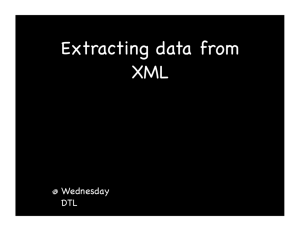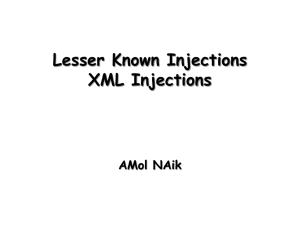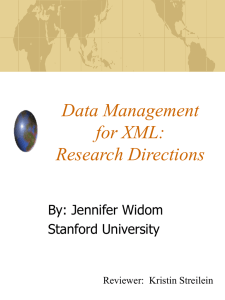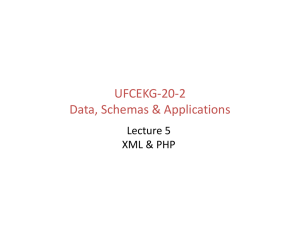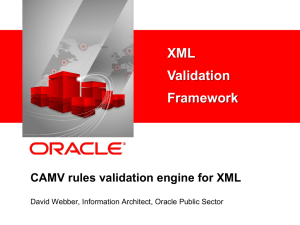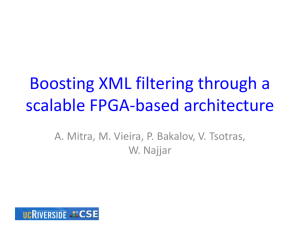Web Technologies Accessing Data
advertisement
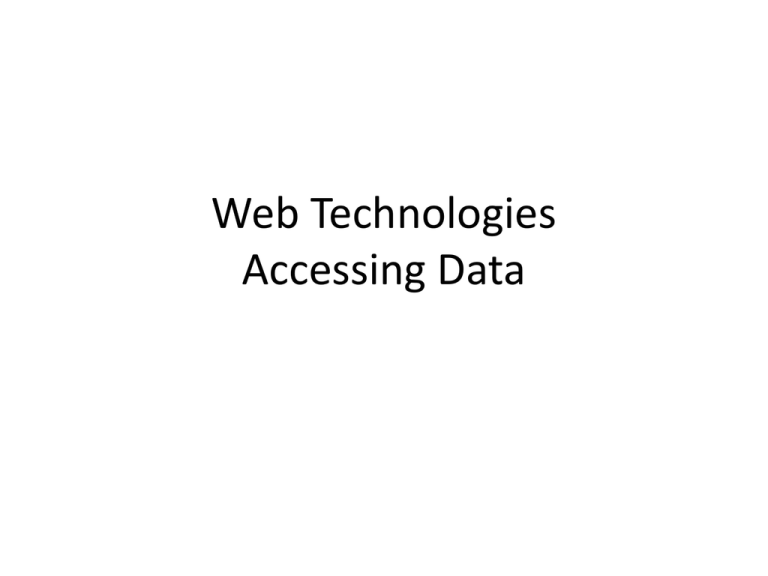
Web Technologies
Accessing Data
Topics
•
•
•
•
•
•
•
HTML pages
XPath
HTML forms
REST
SOAP
XML-RPC
(You don’t have to teach them all, but there
are interesting aspects to all.)
Consumer Price Index
• Suppose we have a financial time series and
need to adjust for inflation.
We need the CPI values for the relevant
period.
• We can look this up on the Web, e.g.
– http://www.rateinflation.com/consumer-price-index/usahistorical-cpi.php
• The data for the most recent 5 years is in the
main table.
• There is also an HTML form that allows the
reader to specify the interval of interest.
We’ll return to this.
• How to read the data for the 5 years for each
month?
• Simple answer: readHTMLTable() in the XML
package.
• tbls = readHTMLTable(“http://www.rateinflation.com/consumerprice-index/usa-historical-cpi.php”)
• length(tbls)
• sapply(tbls, nrow)
• We want the last one – 6 rows, including the
header.
• cpi = readHTMLTable("http://www.rateinflation.com/consumer-priceindex/usa-historical-cpi.php",
which = 11, header = TRUE)
• Fix up the types of each column, converting from
a factor to a number.
• cpi= as.data.frame(
lapply(cpi,
function(x)
as.numeric(as.character(x)))
Details
• Interesting answer is how that function is implemented
• Examine the HTML
– find all <table> elements
– process each of these to convert to a data frame
•
•
•
•
find <tr> elements for each row
recognize <th> elements or <thead> for header
<td> for data value
Unravel into data.frame
• Details in the XML package and readHTMLTable()
• But general concepts in Xpath and finding <table>
nodes.
XPath
• Xpath is yet another DSL – domain specific language
• XML documents are trees and Xpath is a mechanism
for finding nodes anywhere within the tree based on a
“pattern”
• Pattern is a path that identifies sequence of nodes by
– direction or “axis” (parent, child, ancestor, descendant,
sideways (<- ->))
– node test – i.e. the name (e.g. table, thead, tr, td)
– predicate test (has an attribute href, has an attribute href =
“foo”)
• Parse the XML/HTML document
– doc = htmParse (“http://www.rateinflation.com/consumer-price-index/usahistorical-cpi.php”)
• Find the <table> elements
tbls = getNodeSet(doc, “//table”)
• getNodeSet() takes a document or a node and
searches through the sub-tree using a
language for describing how to find the nodes
of interest.
• // is srt-hand for “/descendant::table”,
/ is the top-level/root node
descendant is an “axis”
table is the node-test
• If the <table> of interest had an id attribute,
we could add a predicate, e.g.
– getNodeSet(doc, “//table[@id=‘cpi’]”)
• getNodeSet() returns a list of matching nodes.
• We can then recursively extract the nodes of
interest, e.g. the <tr> and the <td> elements
– can walk the tree ourselves if shallow
– or use getNodeSet() to query the subtree easily
• Convert the values in these sub-nodes to R
values and combine into data structure.
Walking the tree
• A node has a name
– xmlName(node)
• Attributes
– xmlAttrs(node),
xmlGetAttr(node, “attrName”)
• Children
– xmlChildren(node) – list of child nodes
• Parent node
– xmlParent(node)
• rows = getNodeSet(tbl, “.//tr”)
do.call(“rbind”, lapply(rows, getRowValues))
• getRowValues gets all the <td> within a <tr>
xpathSApply(row, “.//td”, xmlValue)
• Xpath is similar to regular expressions
– It is a way of expressing complex patters very tersely
and having the Xpath engine implement the search.
• Works for any XML document, so very general.
• Can build up very precise or general queries
– contextual knowledge important to catch all the
nodes we want, but no more.
• We use Xpath for processing XML from many
different sources.
Back to the HTML form
• What if we want more or different years?
– Use the HTML form?
• But how can we mimic selecting the Start and
End years from within R, i.e. programmatically?
• An HTML form is like an R function
– takes inputs, returns an result – an HTML document
• Need to mimic a Web browser to pass arguments
to Web server.
RCurl
• The RCurl package provides an R interface to a
very general and powerful library that can
perform Web queries programmatically and
that are very customizable.
• 3 main functions:
– getURLContent()
– getForm()
– postForm()
• Similar functionality to download.url(), but
much more customizable and general
• Can handle
– Secure HTTP – https
– cookies, passwords
– many additional important options
– maintain state across requests
– multiple concurrent requests
• Examine HTML document and look for the
<form>.
Find the parameter names and use these as
named parameters in getForm()
• x = postForm("
",
form = "usacpi",
fromYear = "1945",
toYear = "1965",
`_submit_check` = "1" )
• Then pass this to readHTMLTable(), which =
http://www.rateinflation.com/consumer-price-index/usa-historical-cpi.php
REST
• Representational State Transfer
• URL represents a state which can be queried or even
updated via remote calls/queries.
• Send parameterized Web query via getForm()
– specify URL
– name value pairs for parameters
• Get back a “document”
– may be
•
•
•
•
raw text
XML
JSONIO
binary data
Process result
• Raw text – use text manipulation, regular
expressions, connections to read into R object
• JSON – JavaScript Object Notation
– use RJSONIO or rjson
• XML – parseXML() and Xpath (getNodeSet())
• Binary data – treat as is, or if compressed,
uncompress in-memory via Rcompression
Zillow
• Zillow provides information and price
estimates of homes
• REST API info at
http://www.zillow.com/howto/api/APIOverview.htm
• Register to get a Zillow Web Service ID
(ZWSID) that you pass in each call to a Zillow
API method
• Call GetZEstimate for a property giving street
address
– getForm("http://www.zillow.com/webservice/GetSearchResults.ht
m",
`zws-id` = ZWSID,
address = “1292 Monterey Ave”,
citystatezip = “Berkeley, CA”)
Result is a text string which contains an XML document
Getting the Result Info
• XML contains <request>, <message>,
<response>
• Extract property id, price estimate, lat./long.,
comparables link, etc.
• Use Xpath and xmlValue().
• doc = xmlParse(txt, asText = TRUE)
• est = doc[[“//result/zestimate”]]
• as.numeric(xmlValue(est[[“amount”]]))
• R package Zillow provides functions for several
of the API methods and hides all the details.
Yahoo Search
• Yahoo Web Search Service
– http://developer.yahoo.com/search/web/V1/webSear
ch.html
• out =
getForm("http://search.yahooapis.com/WebSear
chService/V1/webSearch",
appid = yahooAppIdString,
query = "REST XML Yahoo",
results = 100,
output = "json")
•
•
•
•
•
•
library(RJSONIO)
ans = fromJSON(out)
ans is a list with 1 element named ResultSet
length(ans$ResultSet) # 6
names(ans$ResultSet)
[1] "type"
"totalResultsAvailable"
[3] "totalResultsReturned" "firstResultPosition"
[5] "moreSearch"
"Result"
Individual Search Result Item
• names(ans$ResultSet$Result[[1]])
• [1] "Title"
"Summary"
[4] "ClickUrl”
"DisplayUrl"
[7] "MimeType” "Cache"
"Url"
"ModificationDate"
REST
• Pros:
– simple and easy to get started
– natural exploitation of URLs as resources
• Cons:
– cannot send or retrieved complex/hierarchical data
structures
– have to process result manually
– have to find methods and inputs manually by reading
documentation.
• Do this once and build R functions to hide the details.
•
•
•
•
•
•
•
•
•
•
•
GoogleDocs
EBI
Flickr
Twitter
Zillow
NY Times
Google Trends
MusicBrainz
LastFM
…
R packages for several of these
SOAP
• Simple Object Access Protocol
• Richer and more complex than REST
– can send highly structured data via XML
– Send request in an Envelope containing a request
to invoke a method in the server’s object
• Send arguments as self-describing objects
• SOAP allows us to define new data types and
structures
– application specific data types
SOAP
• Would have to construct the SOAP request
– the envelop and the message
– Too many details to do manually.
• Instead, SOAP service publishes a description of
its methods and data types
– WSDL document – Web Service Description Language
• Code reads this and generates R functions to
invoke each of the methods, coercing the R
arguments to their XML representation and
converting the XML result to an R object.
• Transparent to user
KEGG
Kyoto Encyclopedia of Genes and
Genomes provides a SOAP
Web Service (among other
services) to access its system
functionality (API)
http://www.genome.jp/kegg/soap/
From R
• library(SSOAP)
• u = “http://soap.genome.jp/KEGG.wsdl”
• kegg.wsdl = processWSDL(u)
• kegg.iface = genSOAPClientInterface(, kegg.wsdl)
• Now we have an S4 object containing class
definitions and a list of functions
• names(kegg.iface@functions)
• Invoke the list_databases method
– kegg.iface@functions$list_databases()
– returns a list of S4 Definition objects
– e.g. An object of class "Definition”
Slot "entry_id”:
[1] "nt”
Slot "definition”:
[1] "Non-redundant nucleic acid sequence
database"
• Get enzymes for a specific gene id
• iface@functions$get_enzymes_by_gene('eco:b0002')
– [1] "ec:1.1.1.3" "ec:2.7.2.4"
